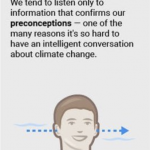Behavioral heuristics are mini short-cuts our brains take. Recently I’ve been wondering if those heuristics can be changed. A little background…
In Thinking Fast and Slow, Daniel Kahneman explores two types of thinking. First there is “System 1”, or what some people might call instinct. System 1 is heavily influenced by heuristics. Then there’s “System 2”, a more structured, reflective thinking. Good UX design helps set things up so that people can make quick decisions, based in System 1.
System 1 relies on behavioral heuristics, so many UX designers learn these heuristics. The goal is to take advantage of heuristics, or “short cuts” the brain uses, to make a design feel more intuitive.
But is the role of UX design always to learn from heuristics? Or could a new design actually create new heuristics?
Can instincts change?
If you take the idea of System 1 (instinct) and System 2 (critical thinking) at face value, the heuristics and short cuts that influence System 1 are unchangeable. After all, how can you change instinct? Humans have instincts that have stayed with us since the Stone Age.
But society – and its related “short cuts” have changed a lot since the Stone Age. In fact, I’m reading Thinking Fast and Slow in 2021, and society has changed a lot in the decade since publication! The first time I became aware of how “instinct” may change in as little as 10 years was in reading chapter 6, “Norms, Surprises, and Causes.”
When something cement does not fit into the current context of activated ideas, the system detects an abnormality[…] Studies of brain responses have shown that violations of normality are detected with astonishing speed and subtlety. […] the same brain response occurs at the same speed when a male voice says “I believe I am pregnant because I feel sick every morning,” or when an upper-class voice says, “I have a large tattoo on my back.”
Daniel Kahneman, Thinking Fast and Slow
I had to reread the last line several times before I understood it. For Kahneman (and likely many people) it is incongruous to hear an upper-class voice say they have a large tattoo. But in the tech world this isn’t a surprising situation at all. What’s more, with health improvements coming constantly, it might not be at all surprising for the next generation to hear a male-sounding voice announce their pregnancy.
Unlike craving more fats than our modern bodies require, which is certainly an evolutionary relic, it appears our brains can adapt to new cultural norms.
Riddle: an example of behavioral heuristics at work
When I was a kid, I remember hearing a riddle:
A man and his son are in a horrible car crash, and the son needs surgery. But just before operating the surgeon sees the child and says “I can’t operate—that boy is my son!”
Inevitably the riddle was met with puzzlement, before finally someone realized: the surgeon might be a woman!
My dad was curious to see if the next generation is less sexist, and so he asked a friend’s 6yr old the riddle. The 6yr old didn’t miss a beat before announcing “the surgeon is the boy’s other dad!”
The next generation may be less homophobic, but cultural sexism is alive and well. Is this “instinct”? Kahneman might say yes – in chapter 3, The Lazy Controller, he writes:
People who are cognitively busy are also more likely to make selfish choices, use sexist language, and make superficial judgments in social situations.”
Daniel Kahneman, Thinking Fast and Slow
But I would argue that these are not the same. Selfish choices may be instinctual. But is sexist language instinctual? I don’t believe so.
Put another way, should UX designers say “no one expects to see a female surgeon, so we won’t show any in our imagery”? Of course not.
UX design can impact behavioral heuristics
What does it mean, that behavioral heuristics are mini short-cuts our brains take? Here’s an example: the availability heuristic means that humans struggle to answer difficult questions like “which letter is more commonly used: k or v” and so we assume the one we remember seeing frequently frequently (available to the brain) is the most common. You might say that the role of a UX designer is to make the user right. If they expect to see more k’s, give them more k’s.
But cultural and societal expectations shape our instincts more than we realize. In one example, Kahneman actually references the role of culture and society. He says “you can be assured that your [thought process] will be quite close to those of other people in your cultural milieu.” In other words, our System 1 brain is not based in an objective reality. It is the world we see, and others in our space see. It is a shared subjective reality.
This leads me to question when UX design should mirror a user’s expectations, and when UX design can make a conscious choice to lead the way.
Common heuristics and how UX design can improve them
System 1 works off of assumptions. System 2 builds new experiences. I posit that we can use UX design to reinforce our hard-working System 2. We can create new heuristics, or overwrite our current heuristics.
To quote a recent conversation with Noz Urbina, founder of Urbina Cosulting and OmnichannelX, “The simplest metaphor is “training”. Heuristics and biases are there innately, but […] they respond to (are trained by) ambient, daily experiences flowing in. Design forms part of those experiences and so plays a part in shaping culture.”
How do we use UX to train our shortcuts? On example is the recent push to make language and design anti-racist. If websites, apps, commercials, and other forms of media show BIPOC doctors, it affects the brain’s assumptions. It can even take advantage of the familiarity bias, by making inclusivity familiar.
UX design can also use some heuristics to impact others. The Halo effect is a type of bias where we assume characteristics about someone based on what we already know. For example, if someone is attractive, you might assume they are also goodhearted. This is one reason that clean, attractive visual design can make apps and websites feel more trustworthy. We can use this heuristic to drive people to trust new concepts, and create new shortcuts to trust. This will build shortcuts that connect new ideas to “trust”.
UX design can always lean on heuristics to impact people. But it can also help update cultural norms and those heuristics (or brain short-cuts) through thoughtful design and content choices.
Let’s make our heuristics better!


